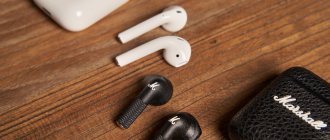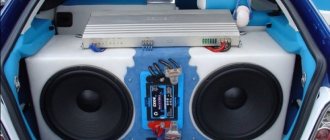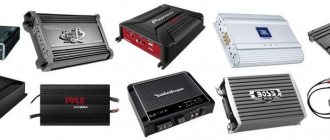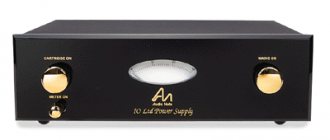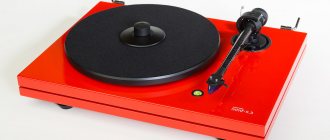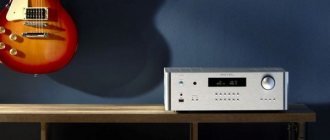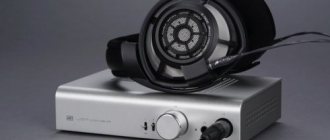Hello music lovers!
Today we’ll talk about one of the most controversial terms in audio. For a long time, in people's minds, Hi-Fi was presented as an expensive acoustic system for geeks from the world of music - “audiophiles”, to listen to which you need to have a good ear for music, and the “ordinary” user will not hear the difference. In fact, this opinion was formed partly due to the fact that Hi-Fi audio was not available in Russia for a long time; equipment from well-known brands was imported only from abroad, so high-quality sound was the lot of a select few. Now such equipment can be easily purchased in many stores. Hi-Fi has become quite widespread and is gradually capturing the hearts (and ears) of people.
Where did honest sound begin?
Let's start with history. As you know, an important event in the world of sound recording was the invention of the phonograph by Thomas Edison back in 1877. Now, in order to listen to music at home, it was not necessary to hire musicians or learn to play yourself.
The expression "high fidelity", which was later shortened to "Hi-Fi", was first used in 1932 by the English engineer Harold Hartley to advertise his outdoor loudspeakers. High fidelity translates as “high fidelity,” which very accurately conveys the meaning of Hi-Fi audio. The issue of quality and accurate reproduction of a recording has been of interest to people for a long time; for example, in the 19th century, a recording was considered to be of high quality if a dog could recognize the owner’s voice. Thanks to this test, one of the famous record companies made a dog sitting next to a gramophone as their logo.
So, why do you need high fidelity in audio? If you look at current trends in multimedia development, you can easily notice that most innovations in the AV field strive to increase the realism of the reproduced content. An increase in resolution, the emergence of 3D multimedia devices (for example, the well-known Oculus Rift), it is now impossible to imagine a TV without FullHD.
The issue of sound realism in Hi-Fi began to be addressed back in the 20th century. Even then, high-quality, realistic sound was of great importance. In the 50s, the first experiments in stereo recording were carried out; vinyl discs appeared, replacing records, which produced a large amount of noise (distortion in the signal).
In the 60s and 70s, home recording equipment was greatly improved and became available to a wide audience. It was at this time that Hi-Fi manufacturers needed to separate “good” and “Hi-Fi” equipment; in 1974, the German Deutsches Institut für Normung (DIN) released the DIN 45500 standard, which defined the standard requirements for sound reproducing equipment.
Then this standard was used to measure:
- Maximum values of unevenness of amplitude-frequency characteristics (AFC) of sound-reproducing equipment (nAFC, dB);
- Nonlinear distortion factor or harmonic distortion factor (THD or Kg,%);
- Noise level - the ratio of the useful signal to the level of intrinsic noise (NOISE, dB).
Methods for measuring these and other indicators are still determined by the current standard DIN 45500.
The best Hi-Fi/High End models of the 2020-2021 season according to EISA
The European Imaging and Sound Association has been selecting the best European AV and photographic equipment since 1982. Every year, experts from almost 30 countries meet and collectively select the best models in various categories. For quite a long time, Russia was represented in this association by three magazines: AvtoZvuk (car audio) and Stereo and Video (home audio/video), as well as Foto&Video (photo and video equipment). Today, the online magazine “Avtozvuk” and blogger Mikhail Borzenkov are speaking for Russia.
At the end of summer, the results of the annual work of the association, including those of our Russian colleagues, are published. Meet the best models of Hi-Fi/High End equipment for the 2020-2021 season (some of them are already available for purchase via the links):
The best floor-standing acoustics in terms of price-quality ratio: Focal Chora 826
Drawing on its extensive experience from audio driver manufacturing to final assembly, Focal has developed affordable floor-standing loudspeaker systems that can sound great in both demo and home environments. The Chora 826's design features a new "Slatefiber" driver for fast response and deep bass, coupled with transparent highs to truly make you want to listen to music for as long as possible. The Chora 826 are easy to install and tune, work even with very modest gain, and sound good in almost any room. Regardless, these speakers offer great performance for the money.
Best Speaker System: SVS Prime Pinnacle
At the top of the SVS Prime range, these floorstanding speakers feature a sleek design and deliver refined performance – not least thanks to the three 16.5cm bass drivers and rear-mounted phasion reflex ports. The woofers are borrowed from the flagship Ultra Tower model, providing bass and percussive drive, while the mids and highs are transparent and pleasant to the ear. The Prime Pinnacle's exterior is slim enough to slip into all but the smallest of rooms, and if you crave warm, rich sound, these speakers will let your audio system truly shine.
The best bookshelf acoustics in terms of price-quality ratio: Monitor Audio Bronze 100
Monitor Audio has built an excellent reputation for compact loudspeakers, earning an EISA Award last year for its bookshelf speaker model, and is expanding its legacy into its sixth generation in 2022. The Bronze 100 excels at handling a wide range of musical styles, delivering an excellent combination of rich bass and clear highs from its proprietary ceramic-coated aluminum and magnesium (C-CAM) drivers, as well as a “grooved” bass reflex port for smoother sound. passage of air flow. Modern design and good amplifier compatibility add to the appeal of these compact and technically advanced speakers.
Wireless speakers: System Audio Legend 5 Silverback
The Danish company System Audio did something completely logical when creating its Legend 5 Silverback speakers: they are active, with separate amplification for each band, and become wireless with the addition of a special stereo hub or third-party transmitter. Using WISA technology, which avoids interference and transmits a signal with parameters up to 192 kHz/24 bits, these speakers can receive signals from various devices - from a computer to a TV. In addition, it has streaming support: from DLNA/UpnP and GoogleCast, to AirPlay and Bluetooth.
It's a sleek, great-sounding wireless solution for your music.
Smart Amplifier: NAD Masters M33
NAD won this category last year with the Masters M10 - not just an amplifier, but a complete "just add speakers" streaming system. This year it has evolved into the Masters M33, which combines a high-end Class D amplifier from Purifi Audio and a proprietary streaming solution. The result is a versatile amplifier with all the features most people need, combining power, detail and drive with extensive connectivity, streaming, DIRAC correction, and controlled from a large touch screen on the front panel. This is truly a modern amplifier from the third decade of the 2000s.
Best Amplifier: Arcam SA30
Arcam joins the current trend of all-in-one streaming devices with its flagship integrated amplifier. In an elegant, sophisticated design, the SA30 combines Class G amplification – for refined and powerful sound – with a wealth of digital technology. The SA30 works as a streamer, in addition to being able to connect almost anything to it - from a TV to a turntable, while the Dirac room acoustics calibration system optimizes the sound - using a computer and the supplied microphone. As we can see, Arcam is expanding its product range, but does not lose focus on the most important thing.
Best High End Integrated Amplifier: Musical Fidelity M8xi
Musical Fidelity has always built superior amplifiers with their philosophy that there is no such thing as too much power. Under the control of the Austrians and under the same wing as Pro-Ject, the company introduced the M8xi, offering an impressive 550 W output, which the device easily delivers thanks to its dual mono. There are both digital and analog inputs for connecting signal sources. Plus, it's not just a powerhouse: it's fast and nimble, delivering music with pinpoint speed and precision, not to mention a ton of fine detail.
Best High End Preamp/Power Amplifier: Rotel Michi P5/Rotel Michi S5
Rotel's high-end sub-brand returns some three decades after its debut: the Michi P5 preamplifier and S5 power amplifier bring the expected sense of solidity, scale and completely natural music playing. Stylish appearance and stunning build quality are complemented by a confident supply of capabilities in a wide range of music genres. Michi equipment is, first of all, about the essence of music and emotions presented to the listener in a completely natural guise. The power amplifier is very flexible in working with various speaker systems, the preamplifier offers a wide range of digital and analog inputs, and quality and reliability are ensured by traditionally painstaking manual assembly.
Best turntable: Thorens TD 1601
The Thorens brand has been unmistakably associated with turntables for almost 120 years, and although the TD 1601 has the design of the classic turntables of the past, under the hood there is state-of-the-art technology. The turntable retains the classic three-point spring suspension of the TD150 from the 1960s and introduces the latest synchronous motor for high rotational stability, as well as a tonearm with electronic micro-lift and auto-stop. A fully mechanical version, Thorens TD 1600, is also available to everyone. This, combined with a balanced output (as well as standard connectors) for even lower noise levels, results in a turntable that combines the classic heritage of a legendary brand with superb, modern sound quality.
Best vinyl turntable in terms of price-quality ratio: Pro-Ject T1
Pro-Ject has been making turntables for almost three decades - from the original Pro-Ject 1 to the more recent Debut models - and in some ways has redefined the budget turntable market. The Pro-Ject T1 is an affordable audiophile turntable with great sound. A precision machined plinth, precision bearing, glass platter and signature aluminum tonearm all contribute to amazingly solid and detailed sound, while the pre-installed Ortofon OM 5E MM cartridge makes this a truly plug-and-play player. . In addition, Pro-Ject offers versions of the turntable with a built-in phono stage and Bluetooth transmitter!
Best DAC in terms of price-quality ratio: iFi Audio Zen
The appeal of the iFi Audio ZEN DAC is very simple: stylish looks, flexibility, solid circuitry and surprisingly mature sound, making this entry-level DAC a downright excellent proposition. This unit proves that 'desktop' audio doesn't have to be inferior to 'proper' hi-fi, and is a really good choice as either a DAC/headphone amp or a digital preamp. iFi Audio ZEN lets you enhance the sound from your computer, and you'll likely find yourself listening to music through it most of the time. And most importantly - all this at a very affordable price: an amazing offer!
Best digital source Volumio Primo
This unassuming looking black box is a great affordable solution for all your streaming needs, from playing music stored on network devices to a variety of music services. Easy and convenient control via browsers or applications, as well as using an on-screen interface via HDMI, is combined in Primo with digital outputs, to which you can connect any DAC to play music from USB media. Compatibility with music formats extends all the way up to DSD over Ethernet or Wi-Fi, so this is a great source to explore the world of streaming.
Best Audio Accessory: Pro-Ject VC-E
Having spearheaded the vinyl renaissance with excellent and highly affordable turntables, Pro-Ject has turned its attention to caring for our precious record collections with the release of the VC-E Record Cleaner. Not only is it compact and affordable, but it's also fast to use, spinning the record at 30 rpm so it can be cleaned in just a few moments: Pro-Ject claims that one spin in each direction should be enough, At the same time, a special clamp keeps the label dry, and the suction lever effectively cleans the surface. What is the result? Less noise, less track wear, even better sound from your favorite recordings.
Best Phono Stage: Primare R15
Designed in a compact body just 35cm wide, the Primare R15 phono stage offers two levels of gain for MM and MC cartridges, with additional resistance and capacitance adjustments to optimize performance with the cartridge being used. Built with the same care as signature power amplifiers, the R15 uses low-noise circuitry based on the flagship R35, and the sound is Primare's familiar blend of substance and substance, complemented by detail and resolution: it's a near-perfect interface for high-end audio. turntable to the line input of your amplifier.
Best Portable Audio Player: FiiO M11 Pro
This portable music player offers arguably best-in-class features and a high-quality chassis with an edge-to-edge touchscreen display. The functionality of the device is almost unparalleled - the M11 Pro can be used as a Bluetooth receiver and transmitter, a USB DAC and a USB audio player; In addition, it is possible to play from the built-in storage (expandable up to 2 TB) and streaming services. The six-core Samsung Exynos processor ensures a responsive interface and ease of control. Meanwhile, two AK4497EQ DACs with Velvet Sound architecture support Hi-Res audio up to 384 kHz/32-bit, as well as MQA decoding. A trio of output jacks - for connecting headphones and other devices - is complemented by high-quality built-in amplification with low distortion.
Best over-ear headphones: DALI iO-6
Many speaker manufacturers began producing their own headphones, but apparently no company had such a spectacular “start” in this segment as DALI. The iO6 headphones are not only a wireless design, but also excellent protection from extraneous sounds, with a closed-type design and three modes of active noise reduction. For those who find these arguments not enough, the headphones offer best-in-class battery life - up to 30 hours without recharging! Add to this the powerful, open and informative sound and you have nothing short of a sensational debut.
Best Portable DAC/Headphone Amplifier: Audioquest DragonFly Cobalt
The latest addition to the Audioquest DragonFly range, the Cobalt model not only converts the widest range of audio formats from your computer, it also features a high-quality headphone amplifier and is capable of delivering superb Hi-Fi audio - all in a device no bigger than a regular USB flash drive. It's practically the perfect portable audio companion: simply plug it into the USB port of your computer or other gadget, which will simultaneously supply power and stream music to DragonFly. Then simply plug in your favorite headphones and you'll have everything you need for great sound wherever you go.
read other news
What is the difference between Hi-Fi and “non-Hi-Fi”?
Some might say at the price, but that's not entirely true. Hi-Fi equipment allows you to feel like a participant in a concert of your favorite performer, find yourself in the center of the events of a film, and hear in your recordings what you could not hear before due to the parameters of the speaker system. As practice shows, once a person listens to audio recordings on high-quality Hi-Fi equipment, he no longer wants to go back to ordinary plastic speakers. But the main thing is the feeling. Hi-Fi doesn't just transmit sound, it conveys sensations, it conveys musical taste and richness. By closing your eyes, you can clearly imagine the entire musical scene of the recording - that the vocalist is standing slightly to the left of center, and the bass player is in the background. If a car in a movie goes into the sunset, the sound of its engine will recede, not fade away.
Hi-Fi is very expensive and costs hundreds of thousands of rubles?
Let's look at this common myth about hi-fi systems.
Of course, we can cite the example of top Hi-End (this is definitely a marketing term) brands, with a pair of floor-standing speakers costing from 1.5 million rubles. In design and execution, they are certainly beautiful and unique. But the price of acoustics is not proof of the level of Hi-Fi. Let's take the Danish company Dali as an example. This company was founded in 1983 and is engaged in the production of speaker systems. All speakers are assembled at a factory in Denmark by hand (the master signs an autograph on each of them); the speakers use impregnated paper cones reinforced with wood pile and a silk dome. These speakers are made from MDF; the plant spends more money on improving quality at all stages of production. You may immediately think that they should cost like a new car. In fact, the price of the 5.0 Zensor series kit (this series also uses the technologies described above) will be less than 70 thousand rubles. A multi-channel receiver with support for all modern standards, for example Onkyo TX-NR636, will cost up to 40 thousand rubles.
As a result, we get a complete ready-made home multimedia system suitable for any content - good music, realistic films and games - all this will help bring the above set to a new level of perception.
So what is Hi-Fi? And is it available?
These are not performance numbers, this is not expensive equipment for the elite, Hi-Fi is a new experience that you can feel thanks to the high fidelity of sound transmission and the approach to creating speaker systems and other audio components. Will a person who is not experienced in sound be able to hear it? Definitely can. You just need to tell what and how to listen. This is what we would like to do for the readers of our blog, because this is a very interesting and extensive topic. We have a bunch of numbers and graphs. We are waiting for feedback, friends! ~ iCover Music Team
Question from a music lover to audiophiles: what is HI-FI and where can I find it?
I don’t know about the overestimation of radio engineers, for me personally this is the assessment of my colleagues and acquaintances: musicians, music lovers, audiophiles and ordinary people, when they ask my opinion on comparing the sound of different setups, whether it is worth changing setup A to setup B or its separate components, asking for recommendations on choosing home theater components, regarding the quality of mixing and sound installation at a concert, asking to evaluate the CD project they recorded and give recommendations on what could be done better, despite the fact that I do not consider myself a professional in the field of audio, although I do they are already 50 years old and at one time managed to work in a design bureau, was involved in the development of an amplifier and fine-tuning it to mass production. None of my acquaintances, relatives and friends buy an amplifier, receiver, acoustics, subwoofer, media player, TV or projector without consulting me and without my approval of the device they have chosen, including computers. “And low self-esteem manifests itself in the fact that a person cannot objectively assess the abilities of his ears, in the case of an audiophile. He thinks that he is not a pro, and that in general the entire Internet is populated by non-pros, moreover, because the pros are all at work, and they have enough people to talk to about their interests.” I observe exactly the opposite phenomenon regarding self-esteem in the case of audiophile. Do you really think that there is at least one professional here on the forum? None of the audiophiles fundamentally wants to objectively assess the abilities of their ears using a well-designed double-blind test; all actually conducted tests of this type ended in one thing: they cannot hear what they stated, so they oppose it, do not want to acknowledge it and have a negative attitude towards it. They prefer “tests”: I connect the wire of brand A at price X, and then I connect wire B at price Y, and I hear that the wire of brand A gives the best sound - this is a complete lack of objectivity: I connect it myself, I change it myself, I hear it myself, there is no independent assessment and the influence of psychoacoustics and self-hypnosis is not excluded. For me, professionalism is the recognition of a particular individual as such by other reputable professionals and the rest of the musical community. For me, an example of well-known professionals in the topic of multi-channel audio mixing that is close to me: Al Schmidt, Elliot Shiner, James Guthrie, who were entrusted with mixing cult rock masterpieces. As for the ears of an audiophile, from the experience of communicating with them, I can report that none of them stood even close to professionals, because audiophiles have a very subjective perception and most of them for some reason love colored sound, about neutral sound they say: ugly and poor quality - in in general, unlike sound engineers who strive for a neutral sound, here taste is in all its glory, they live in captivity of audiophile myths and legends: for most of them, the only correct sound is stereo, good acoustics are only large floor-standing speakers, good sound is only given by an expensive stereo amplifier, Lossless movies can be listened to on stereo, a subwoofer spoils the sound, wires can affect the sound at the component level, etc. And of course, everyone within this forum can declare themselves a “professional” or “expert” or even receive confirmation here from the same “professionals” and “experts”, but this has nothing to do with real professionalism, because this is a “professional” "Only within this forum.

